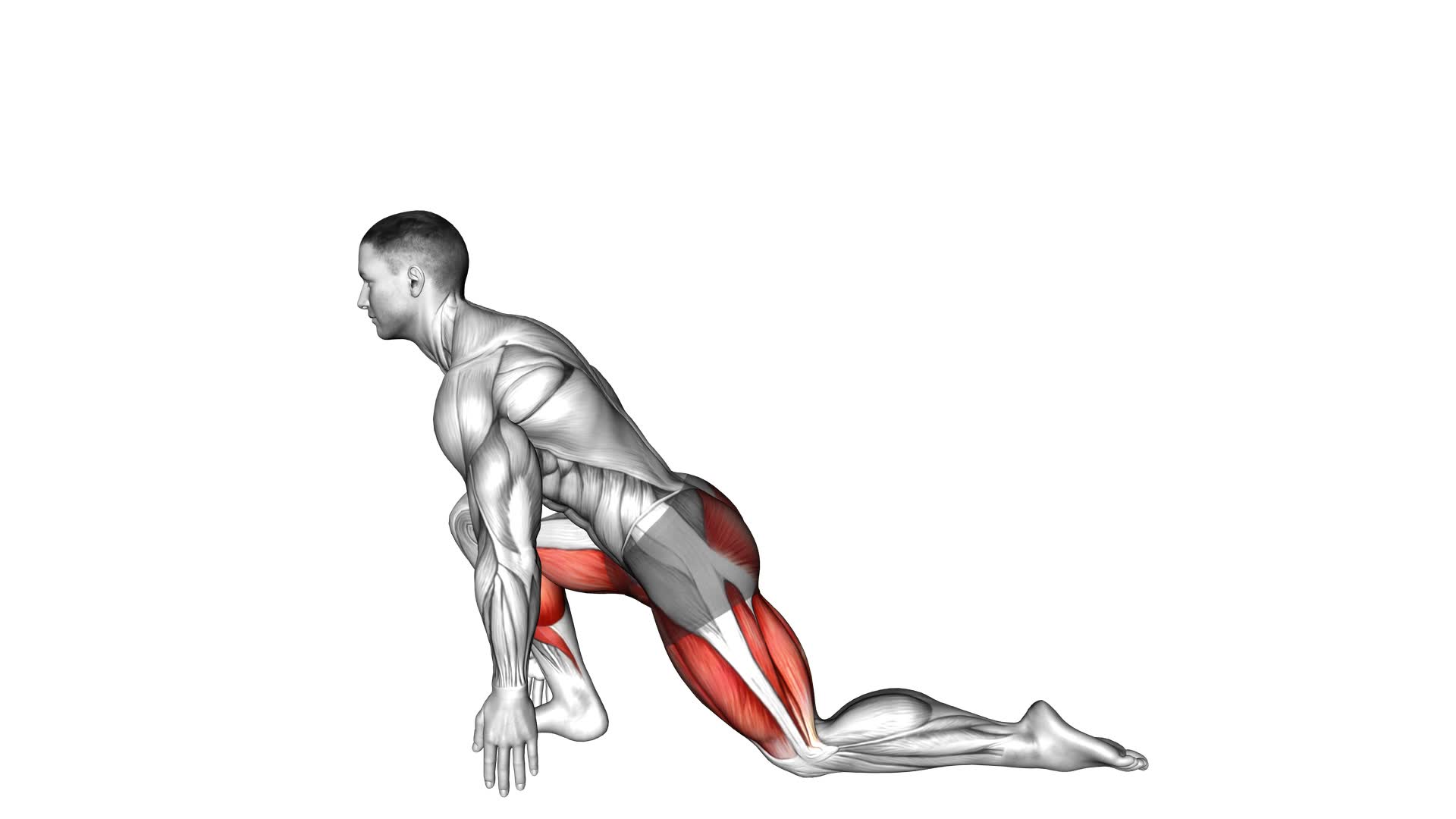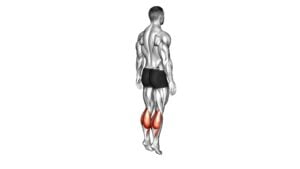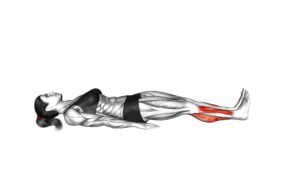Dynamic Weight Bearing Ankle Dorsi Flexion (male) – Video Exercise Guide & Tips

Are you looking to improve your ankle strength and flexibility? Look no further! In this video exercise guide, we will walk you through the technique for dynamic weight-bearing ankle dorsi flexion.
Watch This Exercise Video
This exercise is essential for building stability and preventing injuries. We will also provide you with tips and common mistakes to avoid.
So, grab your mat and get ready to take your workout routine to the next level with ankle dorsi flexion!
Key Takeaways
- Ankle dorsi flexion is crucial for balance, stability, and mobility during exercises and activities.
- Regular ankle dorsi flexion exercises increase ankle mobility and range of motion.
- Strengthening the lower leg muscles through ankle dorsi flexion reduces the risk of ankle injuries.
- Improved ankle mobility enhances performance in running, jumping, and squatting.
Importance of Ankle Dorsi Flexion
To maximize the benefits of your workout routine, it's crucial that you understand the importance of ankle dorsi flexion. Ankle dorsi flexion refers to the movement of bringing your toes up towards your shin. This movement is essential in maintaining balance and stability during various exercises and activities.
One of the main benefits of ankle dorsi flexion is that it helps to improve your overall ankle mobility. By regularly performing exercises that target ankle dorsi flexion, you can increase the range of motion in your ankles, allowing for better movement and performance in activities such as running, jumping, and squatting.
In addition to improving ankle mobility, ankle dorsi flexion exercises also help to strengthen the muscles in your lower legs. These exercises specifically target the muscles in your calves and shins, which are responsible for stabilizing your ankles and supporting your body weight during weight-bearing activities. By strengthening these muscles, you can reduce the risk of ankle injuries and improve overall lower body strength.
Now that you understand the benefits of ankle dorsi flexion, it's important to prepare for dynamic weight-bearing exercises. This will ensure that you're properly warmed up and ready to perform exercises that require ankle stability and mobility.
Preparing for Dynamic Weight Bearing Exercises
Now, let's transition into preparing yourself for dynamic weight-bearing exercises by focusing on proper warm-up and stability techniques.
Preparing your body for these exercises is crucial in preventing ankle injuries and maximizing performance. Before starting any dynamic weight-bearing exercise, it's important to engage in a thorough warm-up routine. This should include activities such as light jogging, jumping jacks, or skipping to increase blood flow to the muscles and joints.
Additionally, incorporating ankle mobility exercises into your warm-up can help improve your range of motion and reduce the risk of ankle injuries. These exercises can include ankle circles, ankle dorsiflexion stretches, and ankle plantarflexion stretches.
Once you have completed your warm-up, it's essential to focus on stability techniques to ensure proper alignment and control during the dynamic weight-bearing exercises. This can be achieved through exercises such as single-leg balance exercises, ankle stability drills, and lateral movements.
Dynamic Weight Bearing Ankle Dorsi Flexion Technique
You can perform the dynamic weight bearing ankle dorsi flexion technique to improve ankle mobility and strengthen the muscles in your lower leg. Ankle mobility exercises are crucial for maintaining proper joint function and preventing injuries. The ankle dorsi flexion exercise specifically targets the muscles that control dorsiflexion, the movement that brings your toes closer to your shin.
To perform this exercise, begin by standing with your feet shoulder-width apart and your toes pointing forward. Place your hands on a stable surface for support, such as a wall or chair. Slowly lift your toes off the ground while keeping your heels firmly planted. Lower your toes back to the ground and repeat for a set number of repetitions.
The benefits of ankle dorsi flexion include increased ankle range of motion, improved balance and stability, and enhanced performance in activities that require ankle mobility, such as running, jumping, and squatting. Additionally, this exercise helps to strengthen the muscles in your lower leg, including the calf muscles and the muscles that support the arch of your foot.
Incorporating dynamic weight bearing ankle dorsi flexion into your exercise routine can help prevent ankle injuries and improve overall lower leg function. Remember to start with a light weight or no weight at all, gradually increasing the load as your strength and mobility improve. Always consult with a healthcare professional or a certified trainer before starting any new exercise program.
Common Mistakes to Avoid
To maximize the effectiveness of the dynamic weight bearing ankle dorsi flexion exercise, it's important to avoid these common mistakes.
First and foremost, you must avoid using incorrect form during the exercise. This means making sure that your ankle is properly aligned and that you're using the correct range of motion. Incorrect form can lead to ineffective results and increased risk of injury.
Another common mistake to avoid is rushing through the exercise. Ankle mobility training requires patience and control. It's important to move slowly and deliberately, allowing your muscles to fully engage and stretch. Rushing through the exercise can diminish its benefits and increase the likelihood of strain or injury.
Furthermore, it's crucial to avoid overexertion. While it's important to challenge yourself during ankle mobility training, pushing too hard can lead to muscle fatigue and potential injury. It's essential to listen to your body and work within your limits.
By avoiding these common mistakes, you can ensure that you're getting the most out of your dynamic weight bearing ankle dorsi flexion exercise.
Now, let's move on to the next section where we'll discuss tips for progression and variation to further enhance your ankle mobility training.
Tips for Progression and Variation
To progress and vary your dynamic weight bearing ankle dorsi flexion exercises, there are a few key points to keep in mind.
First, gradually increase the difficulty level by adding resistance or increasing the range of motion. This will help challenge your ankle muscles and promote further strength and flexibility gains.
Second, be cautious not to overexert yourself or push beyond your limits, as this can lead to injury. Listen to your body and stop if you experience any pain or discomfort.
Increasing Difficulty Levels
To progress and vary the difficulty levels of dynamic weight bearing ankle dorsi flexion exercises, try incorporating different resistance levels and challenging positions.
By increasing the resistance, such as using ankle weights or resistance bands, you can add more difficulty to the exercise. This will challenge your ankle muscles and improve their strength and flexibility.
Additionally, you can try performing the exercise on an unstable surface, like a balance board or a foam pad. This will require your ankle muscles to work harder to maintain stability, further enhancing the difficulty level.
Another option is to perform the exercise on one leg instead of two, which will increase the demand on your ankle muscles.
These progression techniques and advanced modifications will help you continually challenge yourself and make progress in your ankle dorsi flexion exercises.
Avoiding Overexertion and Injury
To avoid overexertion and injury while progressing and varying the difficulty levels of dynamic weight bearing ankle dorsi flexion exercises, ensure that you listen to your body and avoid pushing yourself beyond your limits. Here are three tips to help you prevent strain and maintain proper form techniques:
- Start with proper warm-up: Prior to engaging in any exercise, it's crucial to warm up your muscles and joints. This can be done through light cardio exercises or dynamic stretches specific to the ankle and calf muscles.
- Gradually increase intensity: Progression is key, but it should be done gradually. Avoid sudden jumps in difficulty levels to prevent overexertion. Increase the load or intensity incrementally over time to allow your body to adapt and strengthen.
- Focus on technique: Pay close attention to your form throughout the exercise. Maintain a neutral spine, engage the core, and ensure that your ankle stays aligned with your knee and hip. This will help prevent unnecessary strain and reduce the risk of injury.
Incorporating Ankle Dorsi Flexion Into Your Workout Routine
Incorporate ankle dorsi flexion into your workout routine to improve ankle strength and flexibility. Ankle dorsi flexion refers to the movement of pulling your toes towards your body, which helps to increase the range of motion in your ankle joint. By including ankle dorsi flexion exercises in your workouts, you can enhance ankle mobility and reap multiple benefits.
One of the main advantages of ankle dorsi flexion exercises is improved ankle mobility. These exercises target the muscles and tendons in the ankle, helping to increase their flexibility and range of motion. This can be particularly beneficial for athletes or individuals who engage in activities that require quick changes in direction, such as basketball or soccer.
Additionally, ankle dorsi flexion exercises can help strengthen the muscles in your lower leg, including the calf muscles and the muscles that support the arch of your foot. This improved strength can provide better stability and balance, reducing the risk of ankle sprains or other injuries.
Incorporating ankle dorsi flexion exercises into your workout routine is relatively easy. You can perform simple exercises like ankle circles, where you rotate your ankle in a circular motion, or ankle stretches, where you actively pull your toes towards your body. These exercises can be done before or after your main workout, or even as a standalone mini-workout to specifically target ankle mobility.
Frequently Asked Questions
How Often Should I Perform Dynamic Weight Bearing Ankle Dorsi Flexion Exercises?
You should perform dynamic weight bearing ankle dorsi flexion exercises at a frequency that suits your individual needs and goals.
The frequency of these exercises can vary depending on factors such as your current level of fitness, any pre-existing injuries or conditions, and your desired outcomes.
It's important to consult with a qualified healthcare professional or a certified trainer who can provide specific recommendations and modifications for ankle dorsi flexion exercises based on your individual circumstances.
Can Ankle Dorsi Flexion Exercises Help Prevent Ankle Sprains?
Ankle dorsi flexion exercises can be beneficial in preventing ankle sprains. By strengthening the muscles and improving the range of motion in your ankle, these exercises help to stabilize the joint and increase its resistance to injury.
Athletes and individuals undergoing rehabilitation can both benefit from incorporating ankle dorsi flexion exercises into their routine. Regularly performing these exercises can help to improve ankle stability and reduce the risk of sprains during physical activities.
Are There Any Age Restrictions or Limitations When It Comes to Performing These Exercises?
When it comes to performing ankle dorsi flexion exercises, it's important to consider any age restrictions or exercise limitations that may exist.
Different individuals may have varying abilities and physical conditions that could impact their ability to perform these exercises safely.
It's advisable to consult with a healthcare professional or a qualified trainer to assess your specific situation and determine if there are any age restrictions or exercise limitations that you should be aware of before engaging in these exercises.
Can I Still Perform Ankle Dorsi Flexion Exercises if I Have a Previous Ankle Injury?
If you have a previous ankle injury, it's important to consult with a healthcare professional before performing ankle dorsi flexion exercises. They'll be able to assess your injury and determine if it's safe for you to engage in these exercises.
In some cases, alternative exercises may be recommended to avoid further strain or damage to the ankle. It's crucial to prioritize your safety and follow the guidance of a medical professional.
What Are the Potential Benefits of Incorporating Ankle Dorsi Flexion Exercises Into My Workout Routine?
Incorporating ankle dorsi flexion exercises into your workout routine can have several potential benefits. These exercises can help improve ankle flexibility, range of motion, and overall ankle strength.
By properly performing ankle dorsi flexion exercises, you can also enhance your balance and stability, which can be beneficial for various activities and sports.
It's important to follow the proper technique for ankle dorsi flexion exercises to maximize their benefits and minimize the risk of injury.
Conclusion
Incorporating dynamic weight bearing ankle dorsi flexion exercises into your workout routine is crucial for improving ankle mobility and stability. By properly preparing and using the correct technique, you can effectively target the muscles involved in ankle dorsi flexion.
Avoiding common mistakes and progressing gradually will ensure optimal results. Remember to consult with a healthcare professional before starting any new exercise program.
Start incorporating ankle dorsi flexion exercises today and enhance your overall ankle function.

Author
Years ago, the spark of my life’s passion ignited in my mind the moment I stepped into the local gym for the first time. The inaugural bead of perspiration, the initial endeavor, the very first surge of endorphins, and a sense of pride that washed over me post-workout marked the beginning of my deep-seated interest in strength sports, fitness, and sports nutrition. This very curiosity blossomed rapidly into a profound fascination, propelling me to earn a Master’s degree in Physical Education from the Academy of Physical Education in Krakow, followed by a Sports Manager diploma from the Jagiellonian University. My journey of growth led me to gain more specialized qualifications, such as being a certified personal trainer with a focus on sports dietetics, a lifeguard, and an instructor for wellness and corrective gymnastics. Theoretical knowledge paired seamlessly with practical experience, reinforcing my belief that the transformation of individuals under my guidance was also a reflection of my personal growth. This belief holds true even today. Each day, I strive to push the boundaries and explore new realms. These realms gently elevate me to greater heights. The unique combination of passion for my field and the continuous quest for growth fuels my drive to break new ground.



